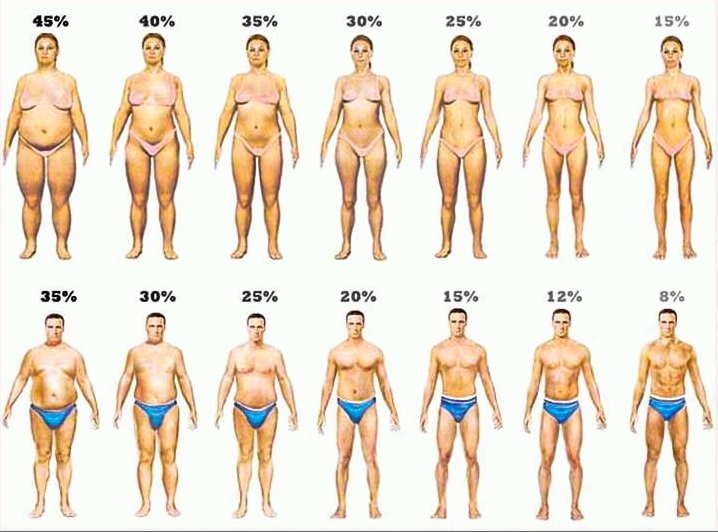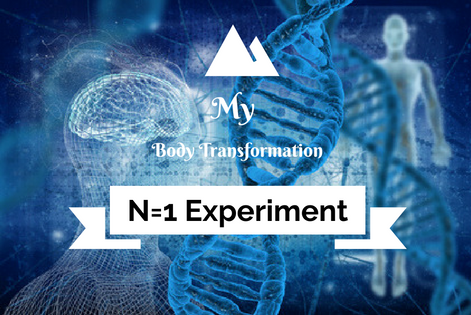
My N=1 Experiment
“All life is an experiment. The more experiments you make the better.”
– Ralph Waldo Emerson
When I began my body transformation the number on the scale was all I cared about. I was in my twenties and like most people my age, caring about other factors like cholesterol and blood sugar wasn’t my main concern. I still hadn’t realized that true health didn’t come from just dropping my overall body weight. As I began my research I discovered the importance of being aware of key health markers in my blood work. This way I could get a glimpse of where my health was at a cellular level.
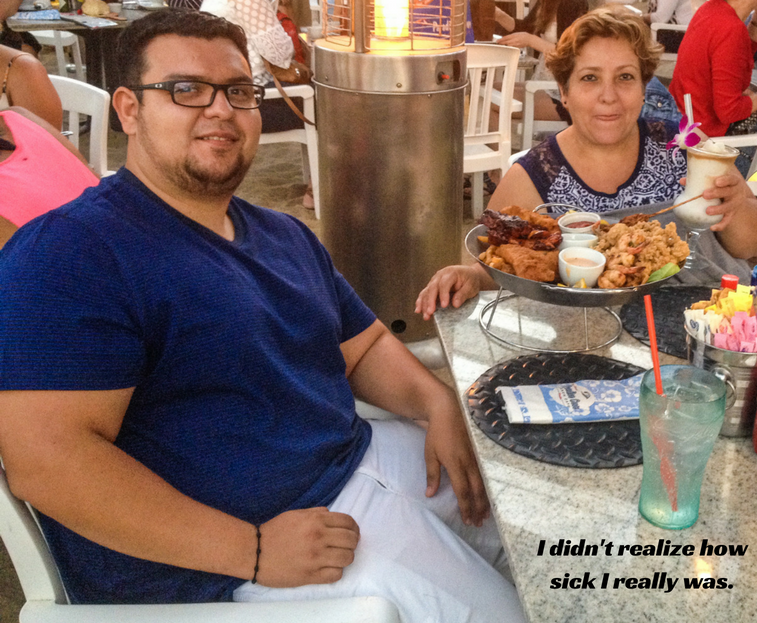
The day I began my transformation was the day my health finally came crashing down, hitting rock bottom. I weighed in at around 280 lbs. with 40% body fat. I finally had the motivation to bring on change in my life, but I didn’t know where to start. So, I began by reading books from various fitness experts and went through the gauntlet of confusion since most of them had different theories. My first approach was to experiment with the “Balanced diet”, also called “Everything in Moderation”. For 3months I counted my calories making sure to watch my portions. Every single piece of food that went into my mouth was absolutely counted and logged. And you better believe I saved room in those calories for ice cream and cookies. Lots of people do this and it works for some of them. Their focus is on overall calories with no mention of what type of calories. So of course, I gave it a try and learned that it takes a lot of willpower fighting off cravings on a higher carb/calorie restricted diet. After 3 months, I learned that this was not working for my body type.

Following the mainstream trainer’s advice, “that everything in moderation works, as long as you stay under your calories”, didn’t work for someone as metabolically damaged as I was. I learned that for bigger endomorph body types like mine, more advanced methods are needed to see long-term weight loss. The reason is that your body changes through hormones signals that it gets from the type of foods you feed it, not just the amount of calories consumed. You can see below in the results of my body scan that I did lose weight at first but in the 3rd month I also lost muscle mass and gained back more fat mass. I was essentially starving myself at a cellular level which caused my metabolism to use my muscles for fuel, due to the lack of energy. While at the same time, storing more fat in case of a possible famine. Even with all my efforts of constant hunger, I wasn’t getting any closer to my goals. After this failed experiment, I kept reading and learning various methods. That’s when I decided to go with a whole food paleo approach.

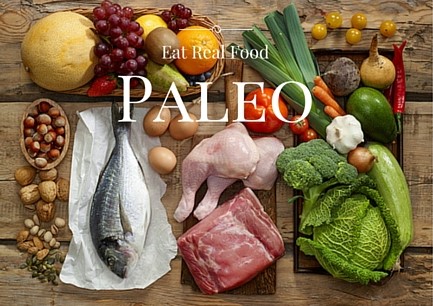 Paleo helped me begin a process of detoxification at a cellular level. This is where I feel I really began my transformation from the inside out and truly started to see progress. I stopped eating processed junk like chips, cookies, and fast food and started to include more fruits, veggies, and healthy homemade meals, but I wasn’t focused on low-carb. I saw a big improvement in my body scan results and also in the mirror. I wasn’t just eating healthier paleo friendly foods but I was also doing heavy resistance training in the gym. My friends and family began to really start to notice that I was losing weight and getting in better shape. You will see in the scans below that I was able to maintain my muscle mass while also burning away 12.7 lbs. of pure fat mass. This was from the end of month 3, through month 5. This started to give me a more muscular aesthetic since I wasn’t just getting skinny, I was strengthing my muscular frame. Resistance training was key to my body transformation. It helped accelerate the process of change in my body, begging the shift from obese to getting fit and strong. But I wasn’t done, I kept reading and learning which lead me to discover the Ketogenic diet.
Paleo helped me begin a process of detoxification at a cellular level. This is where I feel I really began my transformation from the inside out and truly started to see progress. I stopped eating processed junk like chips, cookies, and fast food and started to include more fruits, veggies, and healthy homemade meals, but I wasn’t focused on low-carb. I saw a big improvement in my body scan results and also in the mirror. I wasn’t just eating healthier paleo friendly foods but I was also doing heavy resistance training in the gym. My friends and family began to really start to notice that I was losing weight and getting in better shape. You will see in the scans below that I was able to maintain my muscle mass while also burning away 12.7 lbs. of pure fat mass. This was from the end of month 3, through month 5. This started to give me a more muscular aesthetic since I wasn’t just getting skinny, I was strengthing my muscular frame. Resistance training was key to my body transformation. It helped accelerate the process of change in my body, begging the shift from obese to getting fit and strong. But I wasn’t done, I kept reading and learning which lead me to discover the Ketogenic diet.
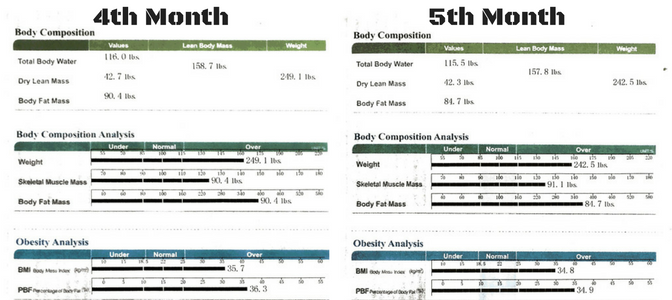
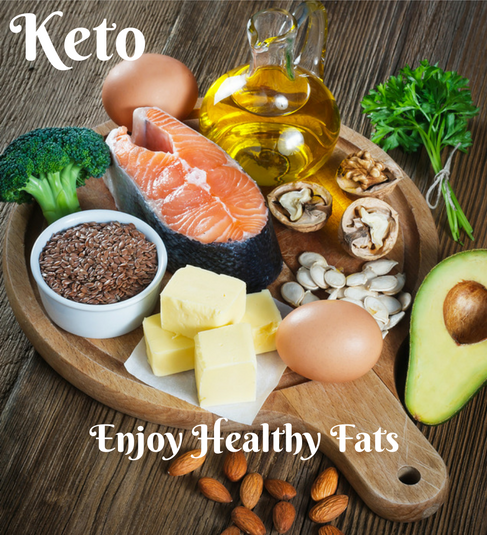 I wanted to keep seeing results; I firmly believe you should never stop learning, never stop trying to progress, so I decided to give keto a try. This shift into the ketogenic diet took a total different approach that I previously never heard of. But I was willing to give it a try, so one of the big shifts I made in the next 4 months was to cut out almost all the fruits and starchy veggies that I was eating on the paleo diet. The theory behind keto was to reduce my carbohydrates low enough that I allow my body to shift engines. Going from a toxic and inefficient sugar burner to a ketone fueled fat burning machine. It took some time to adjust but after the first 2 weeks, I felt a shift in my energy and focus that changed everything. This new upgraded way of using nutrition, allowed me to be free from my ravenous hunger. The shift happened once my body became fat adapted and was now able to use the healthy fats on my plate and on my body as its main fuel source.
I wanted to keep seeing results; I firmly believe you should never stop learning, never stop trying to progress, so I decided to give keto a try. This shift into the ketogenic diet took a total different approach that I previously never heard of. But I was willing to give it a try, so one of the big shifts I made in the next 4 months was to cut out almost all the fruits and starchy veggies that I was eating on the paleo diet. The theory behind keto was to reduce my carbohydrates low enough that I allow my body to shift engines. Going from a toxic and inefficient sugar burner to a ketone fueled fat burning machine. It took some time to adjust but after the first 2 weeks, I felt a shift in my energy and focus that changed everything. This new upgraded way of using nutrition, allowed me to be free from my ravenous hunger. The shift happened once my body became fat adapted and was now able to use the healthy fats on my plate and on my body as its main fuel source.
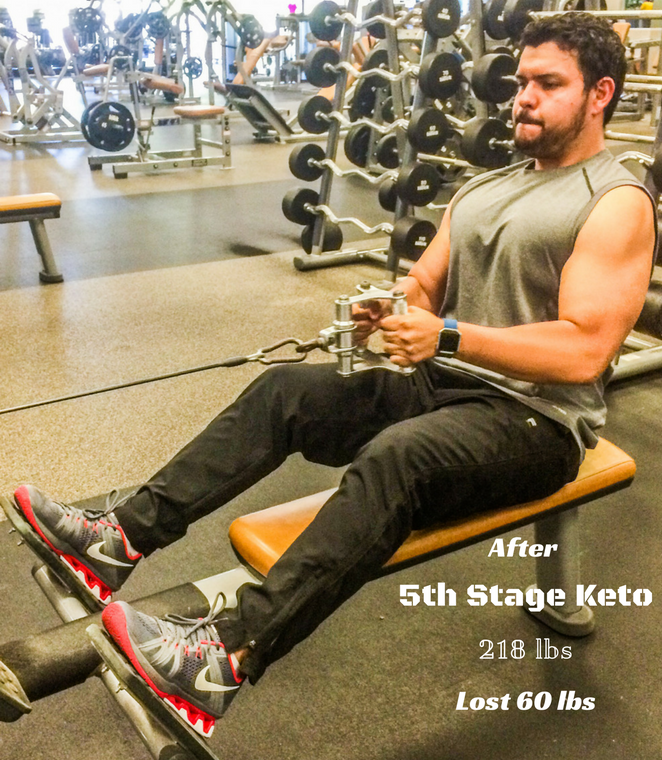 My whole life I have had issues with what felt like never-ending hunger. I felt like I was never satisfied and could snack all day. Always dealing with that constant cycle of thinking about my next meal. Well now that was finally gone; Keto essentially blunted my hunger naturally without the use of any artificial diet pills or surgeries. It allowed me to be in a caloric deficit while still giving my metabolism the nourishing fuel it was asking for through mostly healthy fats & veggies and a moderate amount of protein. I had come a long way from the start of my body transformation and was truly happy with the results. I noticed a big change in my overall daily energy and mood. My gym workouts also improved and my indigestion, that I have had for years, finally went away. My relationships improved since I was never hangry (hungry/angry). This may be TMI, but my sex drive/endurance increased. Also, my focus and cognitive ability improved and all this was most likely from the healthy fats that keto included. I know that I still have more weight to lose but I am not going to wait until I hit my “ideal weight” to be happy with my results. That’s one crucial shift in mentality that I learned along the way. You must enjoy the journey, for it is in the Process of your transformation that the important changes will happen. Those are the inner changes that will make you happy in the end.
My whole life I have had issues with what felt like never-ending hunger. I felt like I was never satisfied and could snack all day. Always dealing with that constant cycle of thinking about my next meal. Well now that was finally gone; Keto essentially blunted my hunger naturally without the use of any artificial diet pills or surgeries. It allowed me to be in a caloric deficit while still giving my metabolism the nourishing fuel it was asking for through mostly healthy fats & veggies and a moderate amount of protein. I had come a long way from the start of my body transformation and was truly happy with the results. I noticed a big change in my overall daily energy and mood. My gym workouts also improved and my indigestion, that I have had for years, finally went away. My relationships improved since I was never hangry (hungry/angry). This may be TMI, but my sex drive/endurance increased. Also, my focus and cognitive ability improved and all this was most likely from the healthy fats that keto included. I know that I still have more weight to lose but I am not going to wait until I hit my “ideal weight” to be happy with my results. That’s one crucial shift in mentality that I learned along the way. You must enjoy the journey, for it is in the Process of your transformation that the important changes will happen. Those are the inner changes that will make you happy in the end.
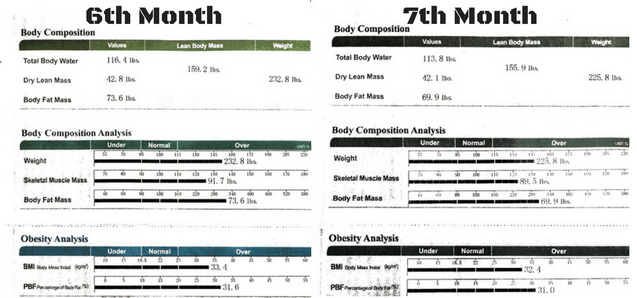
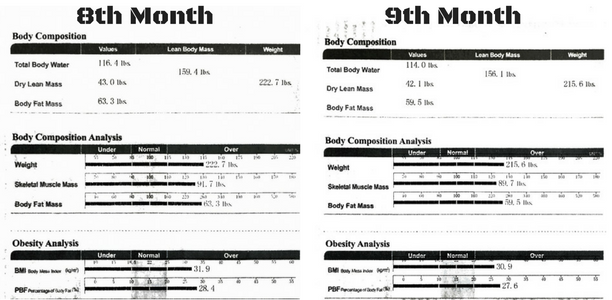

The safety of a Low-Carb Diet
As I researched the keto lifestyle, I learned of the various health benefits that are seen on a ketogenic diet that go far beyond weight loss. (1) So, before I began my shift into nutritional ketosis, I went to my doctor to get an advanced lipid panel. As well as, check other key health markers to see where I was before and after the introduction of the ketogenic diet. Before I explain any of my results I want to go through a very brief recap on how we got to our current beliefs on dietary fat. Also, I want to make it clear that I am not a doctor. I am just relaying what I have learned and I urge you to speak to your own doctor before any types of changes in diet and lifestyle are made. Preferably speak with a doctor who is knowledgeable in the benefits of a paleo and ketogenic diet. You can see if there are any near you at www.PrimalDocs.com & www.lowcarbdoctors.blogspot.com
So, as I progressed in my transformation, people would ask how I was able to drop so much weight. You should have seen their face when I mentioned I ate a lot of bacon, too funny. Not many people know about the possible benefits of the healthy fats in a ketogenic diet. The first thing they would say is, “But eating all that fat will give you high cholesterol and clog your arteries!”. I would reassure them that I did my research and that cholesterol was actually really important for our health, let’s just say they were not convinced. But it’s not their fault, we have been told for several decades that we need to avoid all types of saturated fat to reduce the risk of heart disease. But the reality is that a diet high in carbohydrates especially refined carbs are the real issue.
There have been various groups of people that have thrived on very low amounts of carbohydrates, people like the Canadian Inuit. For hundreds of years, their traditional diet would have long periods of almost entirely fats and protiens. And yes, they were a healthy group of people without high rates of heart disease, (2) or other ailments seen on the Standard American diet. The diet we all consider normal, which is excessively high in refined carbohydrates. Another group of people is the Masai warriors of east Africa, whose traditional diet was also high in fat — and they’re some of the tallest and most athletic people in their region. (3) You see our bodies have learned to function and thrive with this method of eating. It provides us the nourishment we need and is also one of the best forms of naturally lowering systemic inflammation.
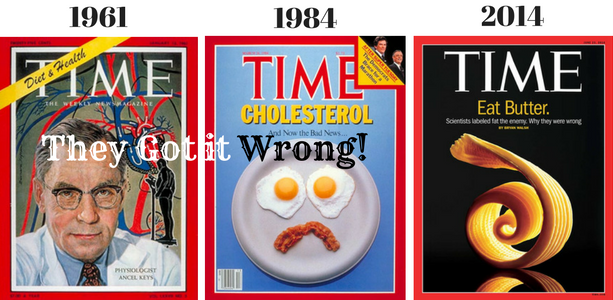 Unfortunately, things took a turn for the worst when we applied the flawed 1950s research of a scientist named Ancel Keys. When the government changed the dietary regulations to support his hypothesis is when obesity and diabetes become a widespread problem. Keys inaccurate study began to convince many that fat was the enemy, and so people began to avoid it at all costs. They began to look for low-fat everything at the stores, and the food manufacturers caught on. Over the years, we started eating higher amounts of processed carbs, increasing the levels of sugar addition and starting our nation’s battle with obesity and diabetes. Thanks to the internet, people are starting to get educated, learning the importance of real whole food, the truth about dietary fats and the real benefits of cholesterol. (4)
Unfortunately, things took a turn for the worst when we applied the flawed 1950s research of a scientist named Ancel Keys. When the government changed the dietary regulations to support his hypothesis is when obesity and diabetes become a widespread problem. Keys inaccurate study began to convince many that fat was the enemy, and so people began to avoid it at all costs. They began to look for low-fat everything at the stores, and the food manufacturers caught on. Over the years, we started eating higher amounts of processed carbs, increasing the levels of sugar addition and starting our nation’s battle with obesity and diabetes. Thanks to the internet, people are starting to get educated, learning the importance of real whole food, the truth about dietary fats and the real benefits of cholesterol. (4)
 Now Let’s dive into my blood work results to compare a few changes that occurred when I shifted into keto. One thing I would like to mention is that I followed a modified ketogenic diet. I have found that this version of keto is much more attainable than the very strict method that is used to treat people with epilepsy or cancer. I was still able to get the majority of the health benefits and enjoy a bit more starchier veggies. Also, since I was doing heavy resistance training, I gave myself the ability to eat a bit more protein to rebuild my muscle mass.
Now Let’s dive into my blood work results to compare a few changes that occurred when I shifted into keto. One thing I would like to mention is that I followed a modified ketogenic diet. I have found that this version of keto is much more attainable than the very strict method that is used to treat people with epilepsy or cancer. I was still able to get the majority of the health benefits and enjoy a bit more starchier veggies. Also, since I was doing heavy resistance training, I gave myself the ability to eat a bit more protein to rebuild my muscle mass.
I tested my ketones during this period with both the Precision Xtra blood Meter as well as the Ketonix breath ketone Analyzer. The highest I got on the blood meter was 1.2 mmol/L, which is in the ranges of nutritional ketosis. On the breath analyzer, I was able to reach Red 7 which is on the high end for that device. I also was able to test my blood glucose which gave me readings ranging around 85-90 mg/dl. I took all measurements at the same time which was around 5pm, just before dinner. Over time my ketones dropped to 0.8 since my body got better at using them and thus didn’t have to make as much.
Key Improvements in My Blood Work
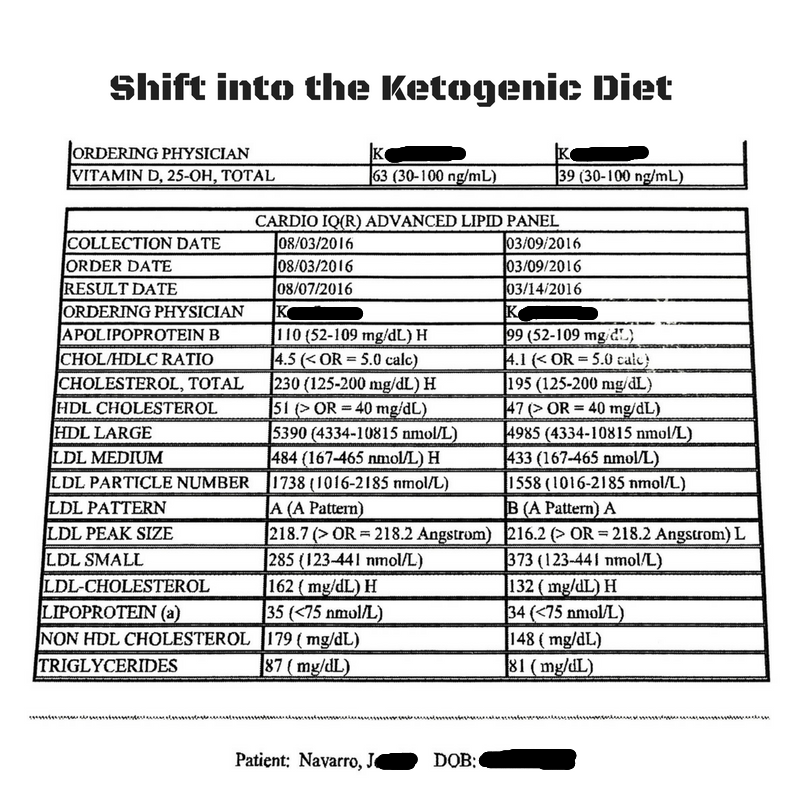 So, let’s talk about the results from my advanced lipid panel. The results from the third column were taken first. Up to this point, I was eating a higher carb modified paleo diet. I was consuming higher amounts of fruits and other starchy carbs. I also would have rice during this stage since I am not dogmatic about my paleo method, remember I was doing this for weight loss not to be a paleo radical. Looking at the first set of results I will say that overall the numbers are great!! The one that jumped out at me was the LDL Pattern B.
So, let’s talk about the results from my advanced lipid panel. The results from the third column were taken first. Up to this point, I was eating a higher carb modified paleo diet. I was consuming higher amounts of fruits and other starchy carbs. I also would have rice during this stage since I am not dogmatic about my paleo method, remember I was doing this for weight loss not to be a paleo radical. Looking at the first set of results I will say that overall the numbers are great!! The one that jumped out at me was the LDL Pattern B.
Let’s me explain some of these health markers, especially the ones I learned that really matter. Now this is going to be a basic explanation of the science. If you haven’t noticed cholesterol and heart disease can get pretty complicated. So with that being said, the old theories of Ancel Keys said that eating high amounts of saturated fats would raise your total cholesterol in the blood which would then give you heart disease by clogging the arteries, but plain and simple that’s just not the case. The reality is that excess amounts of sugar and chronic systemic inflammation are what can raise your heart disease risks, but more on that later. As technology advanced, other scientists were able to discover that cholesterol had more to it than just total cholesterol. Now there was the good kind HDL which stands for High-Density Lipoprotein and the bad kind LDL or Low-Density Lipoprotein. They created a theory stating that high LDL (the bad kind) raised by saturated fats caused the risk of heart disease to raise. But they didn’t realize that LDL has different forms and that not all are harmful. LDL comes in 4 basic forms, a big fluffy form called Large LDL and then there are the gradually denser forms medium, small and very small LDL.
The large and fluffy are considered safe and won’t raise your risk of heart disease. Now it may be hard to believe, but a diet high in saturated fats will shift the size of the LDL to the fluffy kind also known as Pattern A, which is what you want. The smaller denser forms of LDL will have a higher risk of heart disease. A diet high in carbohydrates will cause a shift to these truly dangers types of LDL, also known as Pattern B. Before this was known many scientists thought that having higher levels than normal of LDL-C increased the chances of heart disease. Well, that’s probably because they didn’t know about particle size and how that plays a factor. When I shifted into Keto, I changed the pattern type from the more dangerous small and dense pattern B, to the fluffy and less atherogenic pattern A. Having your blood work done through a standard lipid panel that most doctors use will just show you the basics, without any mention of the pattern type. But if that’s all you have available then don’t worry, it can still be helpful in giving you an idea of where you stand. If you can only get a standard lipid panel, the key marker to watch is the ratio of triglycerides to HDL cholesterol.. You do this by dividing the triglycerides number by the HDL, the closer to 1 the better. If the ratio comes out to be higher than 3, then it means that there is a higher chance that the LDL type is pattern B. Which should make you consider some changes in your diet, like a lower carb approach.
Current blood work labs have the technology to meticulously analyze blood lipids, you just have to convince your doctor to run the more advanced lipid panels. One of the best blood tests to run is the NMR Lipoprofile test. This is an advanced lipid panel that will show the markers we mentioned above. Again, a key marker is HDL cholesterol which is the good kind and it should be above 50-70. This marker can be raised by consuming more saturated fats. The LDL cholesterol should be shifted to Pattern A, which is the fluffy kind and the triglycerides should be under 100. This can by done by reducing the consumption of carbohydrates, especially refined sugars. The current recommended triglyceride ranges start at 150 mg/dL, which is higher than what is optimal for ideal health.
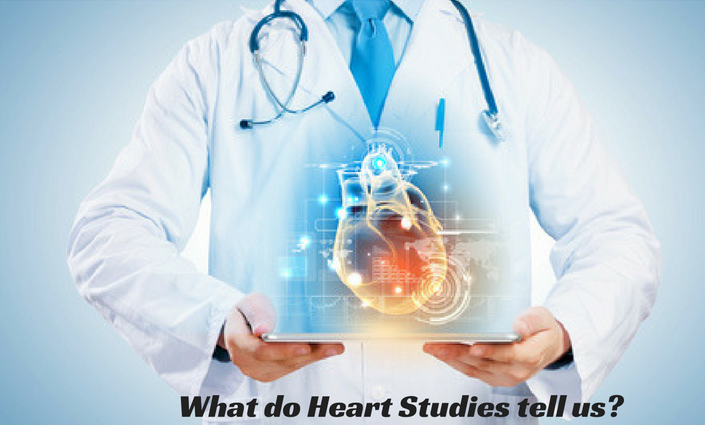
Learning the truth behind cholesterol and the benefits of healthy fats was hard to grasp at first. The complete opposite was fed to us for decades. This was truly a paradigm shift I wasn’t expecting but I was willing to see the science and make the necessary changes – unfortunately, many didn’t get a chance. Over the years, fat-phobia was widespread and deeply embedded. Many began putting great effort into consuming less saturated fat. In efforts to reduce their cholesterol numbers to avoid the risk of heart disease. People followed the recommendations of the food pyramid consuming higher amounts of the so-called heart healthy carbohydrates and focused on trying to buy low-fat everything. Greater numbers of people started to increase their exercise, all for the chance to live a long a healthy life. What were the effects of these changes? Did they work in reducing the rates of heart disease? Sadly, it didn’t and people with regular and so-called healthy LDL numbers began having heart attacks. The eye-opening data was discovered by a nationwide study conducted by the UCLA School of Medicine. (5) They evaluated the blood lipids from 136,905 patients between the year 2000 and 2006, who were admitted to the hospital after a heart attack. They found that 75% of those patients hospitalized had LDL cholesterol within the ranges believed to be safe, below 130 mg/dl. And out of all those patients, 21% of them were on cholesterol-lowering medications. What would be even more shocking to most mainstream doctors is that 50% of those patients who got a heart attack had LDL readings less than 100 mg/dL, which is thought to be the safest levels. This should have made more doctors rethink this flawed theory – but that wasn’t the case. Hopefully, more mainstream doctors will realize that focusing on LDL levels as a key marker for heart disease risk isn’t as reliable as they once thought.
Other Key Health Markers
Now let’s address other health markers that are key in long term health. These next two tests are just as crucial to have run to see where you are in your health. It’s important to remember that heart disease is multifactorial, meaning there are several factors to consider when identifying the cause.
One of the main issues that should be managed is chronic inflammation. It is one of the most important factors that leads to strokes, Heart disease, obesity and diabetes (6). Reducing chronic systemic inflammation from the body can allow the cholesterol your body uses to function flow freely. Reducing the risk of getting trapped inside the endothelial cells that line the inside of the blood vessels. Some of the causes of chronic inflammation are smoking, consuming highly processed carbs like sugar and flour and the foods that are made from them. Inflammation is also caused when you consume omega-6 vegetable oils like canola, soybean and corn oils. To check levels of inflammation, get an HSCRP or High-Sensitivity C-reactive Protein test. This is a test that reads a type of protein the liver makes when there is inflammation in the body. Ideal test results to shoot for are close to 1.0 mg/L. Having this text run can give helpful clues to know how much of this truly dangers factor may be present. My physician didn’t have this important test run on the initial blood draw, he may not have considered it worth checking. I had to remind him that I wanted it checked on the second blood draw. The good news is that the results came out great. Knowing I have no chronic issues with inflammation makes me feel at easy. Its good to know my cholesterol is flowing freely allowing my body to function optimally.

The second test is the Hb-A1C, also called the Hemoglobin A1C. This is another key test that checks the blood sugar levels for the last three months. It’s an important test to have run if diabetes runs in your family. The ideal ranges for the A1C test should be around 4.8 – 5.4, results ranging from 6 – 6.5 is considered prediabetes and if above 6.5 then you are in a diabetic state. Type 2 diabetes has shown to improve and rapidly start to reverse on the ketogenic diet (7). Since it is so effective at dropping blood sugar levels, it is absolutely crucial that type 2’s have their doctor work with them and monitor their levels and reduce any current medications to avoid hypoglycemia.

To conclude, I would say that paleo and keto are both great options when choosing a diet for health and fat loss. They fit together nicely since they share core fundamentals that keep you away from junky fast food and brings you back to healthier homemade meals. The rest really depends on the goals that you have set for yourself. I know that I still have more to learn but that’s the best part about the times we live in. We now have hidden scrolls of life changing secrets that are available at our fingertips. It’s just up to each individual to find what works best for their particular body. I have truly come a long way since I began this journey. I have been able to take what I learned and not just change my life but also the lives of others who had the desire to better themselves.
I offer the challenge and encouragement to anyone who wants to start their own body transformation and reach 5th Stage Keto. This body transformation plan gives you a step-by-step breakdown on how to burn away those extra 30lbs without the crazy hunger pains of mainstream diets. It can help improve your cognitive ability allowing you to be more productive at school or at work. Life is too short to not try and experiment with different strategies that could improve your lifestyle.
Imagine the joy of looking in the mirror and seeing a healthier upgraded version of you. Or think of the possibilities that will come from the freedom of your ravenous hunger. Drop those extra 30 pounds with strategic methods for effective fat loss! Come join the Burn it Family and reach 5th Stage Keto together!!
Learn how to reach 5th Stage Keto Here!!
References
- Paoli A, Rubini A,VolekJS, Grimaldi KA. Beyond weight loss: A review of the therapeutic uses of very-low-carbohydrate (ketogenic) diets. Eur J Clin Nutr. 2013;67:789–796.
- Westman EC. Is dietary carbohydrate essential for human nutrition? Am J Clin Nutr. 2002;75(5): (2002): 951-953; author reply 953-954. & Dewailly E, Blanchet C, Lemieux S, et al. “n?3 Fatty acids and cardiovascular disease risk factors among the Inuit of Nunavik”. Am J Clin Nutr2001;74:464–73.
- Petersen, IB. The Masai keep healthy despite a high-fat diet. Science Nordic (2012).
- Volek JS, Forsythe CE. The case for not restricting saturated fat on a low carbohydrate diet. Nutr Metab. 2005;2(21).
- Sachdeva A. Lipid levels in patients hospitalized with coronary artery disease: an analysis of 136,905 hospitalizations in Get With The Guidelines. Am Heart J.2009 Jan;157(1):111-117.e2.
- http://circ.ahajournals.org/content/109/21_suppl_1/II-2#sec-18
- Paoli A, Rubini A,VolekJS, Grimaldi KA. Beyond weight loss: A review of the therapeutic uses of very-low-carbohydrate (ketogenic) diets. Eur J Clin Nutr. 2013;67:789–796.

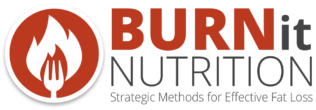

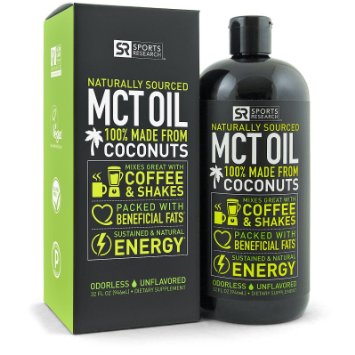 Do this the smart way by having a cup of coffee with a tablespoon of MCT oil for breakfast. MCT or Medium-chain triglyceride is a healthy fat found in coconuts. It is a shorter-chain fat that by-passes the digestive system and goes straight to the liver where it is converted into Ketones. You can find a great brand on the recommendations page of the Burn it Nutrition website. MCT will help increase your cognitive ability and blunt your hunger for hours. You want to try and fast for most of the day, but if your treat meal happens to be a late dinner, then have your workout and after that’s done, have a very light meal. Maybe make yourself a small chicken salad or a Protein shake with MCT oil.
Do this the smart way by having a cup of coffee with a tablespoon of MCT oil for breakfast. MCT or Medium-chain triglyceride is a healthy fat found in coconuts. It is a shorter-chain fat that by-passes the digestive system and goes straight to the liver where it is converted into Ketones. You can find a great brand on the recommendations page of the Burn it Nutrition website. MCT will help increase your cognitive ability and blunt your hunger for hours. You want to try and fast for most of the day, but if your treat meal happens to be a late dinner, then have your workout and after that’s done, have a very light meal. Maybe make yourself a small chicken salad or a Protein shake with MCT oil. This is one of the most crucial strategies to implement. When you train fasted, especially with higher intensity exercises, you force your body to tap into its stored energy and deplete muscle glycogen. Glycogen is a stored form of glucose which comes from the breakdown of carbohydrate. Depleting your muscular glycogen before a carb-up meal with a fasted workout frees up room for the carbs that will be consumed later. Consuming a higher carb meal with full glycogen stores will cause excess glucose to be stored as fat. (4) Ideally, its best to do your fasted workout right before the carb-up meal to increase muscle growth, but if that’s not possible, then at least make sure it’s done sometime before the treat meal.
This is one of the most crucial strategies to implement. When you train fasted, especially with higher intensity exercises, you force your body to tap into its stored energy and deplete muscle glycogen. Glycogen is a stored form of glucose which comes from the breakdown of carbohydrate. Depleting your muscular glycogen before a carb-up meal with a fasted workout frees up room for the carbs that will be consumed later. Consuming a higher carb meal with full glycogen stores will cause excess glucose to be stored as fat. (4) Ideally, its best to do your fasted workout right before the carb-up meal to increase muscle growth, but if that’s not possible, then at least make sure it’s done sometime before the treat meal. Take your time and savor every bite! You have been anticipating this meal for some time, so slow down and enjoy the delightful pleasures of being alive. Startup interesting conversation with your dinner guest and use them as small breaks to your feasting. Slowing down the pace of how you eat should allow your brain to catch up with your stomach and get the signals that you are getting full and should stop eating. Try to be aware of changes in how you feel while eating these different foods. Make a mental note on how your energy and mood changes. Many will notice that they don’t feel as good as when they first sat down to eat. Use this as a reminder next time you are fighting an urge to have an uncontrolled cheat meal.
Take your time and savor every bite! You have been anticipating this meal for some time, so slow down and enjoy the delightful pleasures of being alive. Startup interesting conversation with your dinner guest and use them as small breaks to your feasting. Slowing down the pace of how you eat should allow your brain to catch up with your stomach and get the signals that you are getting full and should stop eating. Try to be aware of changes in how you feel while eating these different foods. Make a mental note on how your energy and mood changes. Many will notice that they don’t feel as good as when they first sat down to eat. Use this as a reminder next time you are fighting an urge to have an uncontrolled cheat meal. 




 Paleo helped me begin a process of detoxification at a cellular level. This is where I feel I really began my transformation from the inside out and truly started to see progress. I stopped eating processed junk like chips, cookies, and fast food and started to include more fruits, veggies, and healthy homemade meals, but I wasn’t focused on low-carb. I saw a big improvement in my body scan results and also in the mirror. I wasn’t just eating healthier paleo friendly foods but I was also doing heavy resistance training in the gym. My friends and family began to really start to notice that I was losing weight and getting in better shape. You will see in the scans below that I was able to maintain my muscle mass while also burning away 12.7 lbs. of pure fat mass. This was from the end of month 3, through month 5. This started to give me a more muscular aesthetic since I wasn’t just getting skinny, I was strengthing my muscular frame. Resistance training was key to my body transformation. It helped accelerate the process of change in my body, begging the shift from obese to getting fit and strong. But I wasn’t done, I kept reading and learning which lead me to discover the Ketogenic diet.
Paleo helped me begin a process of detoxification at a cellular level. This is where I feel I really began my transformation from the inside out and truly started to see progress. I stopped eating processed junk like chips, cookies, and fast food and started to include more fruits, veggies, and healthy homemade meals, but I wasn’t focused on low-carb. I saw a big improvement in my body scan results and also in the mirror. I wasn’t just eating healthier paleo friendly foods but I was also doing heavy resistance training in the gym. My friends and family began to really start to notice that I was losing weight and getting in better shape. You will see in the scans below that I was able to maintain my muscle mass while also burning away 12.7 lbs. of pure fat mass. This was from the end of month 3, through month 5. This started to give me a more muscular aesthetic since I wasn’t just getting skinny, I was strengthing my muscular frame. Resistance training was key to my body transformation. It helped accelerate the process of change in my body, begging the shift from obese to getting fit and strong. But I wasn’t done, I kept reading and learning which lead me to discover the Ketogenic diet.
 I wanted to keep seeing results; I firmly believe you should never stop learning, never stop trying to progress, so I decided to give keto a try. This shift into the ketogenic diet took a total different approach that I previously never heard of. But I was willing to give it a try, so one of the big shifts I made in the next 4 months was to cut out almost all the fruits and starchy veggies that I was eating on the paleo diet. The theory behind keto was to reduce my carbohydrates low enough that I allow my body to shift engines. Going from a toxic and inefficient sugar burner to a ketone fueled fat burning machine. It took some time to adjust but after the first 2 weeks, I felt a shift in my energy and focus that changed everything. This new upgraded way of using nutrition, allowed me to be free from my ravenous hunger. The shift happened once my body became fat adapted and was now able to use the healthy fats on my plate and on my body as its main fuel source.
I wanted to keep seeing results; I firmly believe you should never stop learning, never stop trying to progress, so I decided to give keto a try. This shift into the ketogenic diet took a total different approach that I previously never heard of. But I was willing to give it a try, so one of the big shifts I made in the next 4 months was to cut out almost all the fruits and starchy veggies that I was eating on the paleo diet. The theory behind keto was to reduce my carbohydrates low enough that I allow my body to shift engines. Going from a toxic and inefficient sugar burner to a ketone fueled fat burning machine. It took some time to adjust but after the first 2 weeks, I felt a shift in my energy and focus that changed everything. This new upgraded way of using nutrition, allowed me to be free from my ravenous hunger. The shift happened once my body became fat adapted and was now able to use the healthy fats on my plate and on my body as its main fuel source. My whole life I have had issues with what felt like never-ending hunger. I felt like I was never satisfied and could snack all day. Always dealing with that constant cycle of thinking about my next meal. Well now that was finally gone; Keto essentially blunted my hunger naturally without the use of any artificial diet pills or surgeries. It allowed me to be in a caloric deficit while still giving my metabolism the nourishing fuel it was asking for through mostly healthy fats & veggies and a moderate amount of protein. I had come a long way from the start of my body transformation and was truly happy with the results. I noticed a big change in my overall daily energy and mood. My gym workouts also improved and my indigestion, that I have had for years, finally went away. My relationships improved since I was never hangry (hungry/angry). This may be TMI, but my sex drive/endurance increased. Also, my focus and cognitive ability improved and all this was most likely from the healthy fats that keto included. I know that I still have more weight to lose but I am not going to wait until I hit my “ideal weight” to be happy with my results. That’s one crucial shift in mentality that I learned along the way. You must enjoy the journey, for it is in the Process of your transformation that the important changes will happen. Those are the inner changes that will make you happy in the end.
My whole life I have had issues with what felt like never-ending hunger. I felt like I was never satisfied and could snack all day. Always dealing with that constant cycle of thinking about my next meal. Well now that was finally gone; Keto essentially blunted my hunger naturally without the use of any artificial diet pills or surgeries. It allowed me to be in a caloric deficit while still giving my metabolism the nourishing fuel it was asking for through mostly healthy fats & veggies and a moderate amount of protein. I had come a long way from the start of my body transformation and was truly happy with the results. I noticed a big change in my overall daily energy and mood. My gym workouts also improved and my indigestion, that I have had for years, finally went away. My relationships improved since I was never hangry (hungry/angry). This may be TMI, but my sex drive/endurance increased. Also, my focus and cognitive ability improved and all this was most likely from the healthy fats that keto included. I know that I still have more weight to lose but I am not going to wait until I hit my “ideal weight” to be happy with my results. That’s one crucial shift in mentality that I learned along the way. You must enjoy the journey, for it is in the Process of your transformation that the important changes will happen. Those are the inner changes that will make you happy in the end.


 Unfortunately, things took a turn for the worst when we applied the flawed 1950s research of a scientist named Ancel Keys. When the government changed the dietary regulations to support his hypothesis is when obesity and diabetes become a widespread problem. Keys inaccurate study began to convince many that fat was the enemy, and so people began to avoid it at all costs. They began to look for low-fat everything at the stores, and the food manufacturers caught on. Over the years, we started eating higher amounts of processed carbs, increasing the levels of sugar addition and starting our nation’s battle with obesity and diabetes. Thanks to the internet, people are starting to get educated, learning the importance of real whole food, the truth about dietary fats and the real benefits of cholesterol. (4)
Unfortunately, things took a turn for the worst when we applied the flawed 1950s research of a scientist named Ancel Keys. When the government changed the dietary regulations to support his hypothesis is when obesity and diabetes become a widespread problem. Keys inaccurate study began to convince many that fat was the enemy, and so people began to avoid it at all costs. They began to look for low-fat everything at the stores, and the food manufacturers caught on. Over the years, we started eating higher amounts of processed carbs, increasing the levels of sugar addition and starting our nation’s battle with obesity and diabetes. Thanks to the internet, people are starting to get educated, learning the importance of real whole food, the truth about dietary fats and the real benefits of cholesterol. (4) Now Let’s dive into my blood work results to compare a few changes that occurred when I shifted into keto. One thing I would like to mention is that I followed a modified ketogenic diet. I have found that this version of keto is much more attainable than the very strict method that is used to treat people with epilepsy or cancer. I was still able to get the majority of the health benefits and enjoy a bit more starchier veggies. Also, since I was doing heavy resistance training, I gave myself the ability to eat a bit more protein to rebuild my muscle mass.
Now Let’s dive into my blood work results to compare a few changes that occurred when I shifted into keto. One thing I would like to mention is that I followed a modified ketogenic diet. I have found that this version of keto is much more attainable than the very strict method that is used to treat people with epilepsy or cancer. I was still able to get the majority of the health benefits and enjoy a bit more starchier veggies. Also, since I was doing heavy resistance training, I gave myself the ability to eat a bit more protein to rebuild my muscle mass. So, let’s talk about the results from my advanced lipid panel. The results from the third column were taken first. Up to this point, I was eating a higher carb modified paleo diet. I was consuming higher amounts of fruits and other starchy carbs. I also would have rice during this stage since I am not dogmatic about my paleo method, remember I was doing this for weight loss not to be a paleo radical. Looking at the first set of results I will say that overall the numbers are great!! The one that jumped out at me was the LDL Pattern B.
So, let’s talk about the results from my advanced lipid panel. The results from the third column were taken first. Up to this point, I was eating a higher carb modified paleo diet. I was consuming higher amounts of fruits and other starchy carbs. I also would have rice during this stage since I am not dogmatic about my paleo method, remember I was doing this for weight loss not to be a paleo radical. Looking at the first set of results I will say that overall the numbers are great!! The one that jumped out at me was the LDL Pattern B.


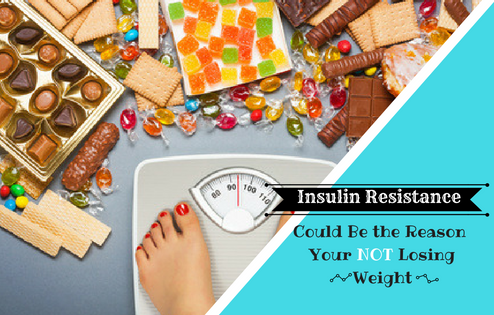
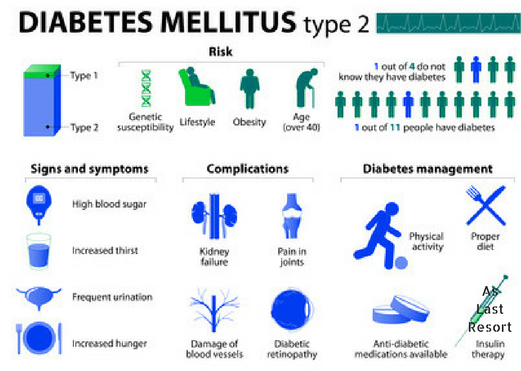 If a person who has already developed insulin resistance continues along the same diet and lifestyle that got them there, then they will most likely develop Type 2 Diabetes. Many studies have shown that this will increase the risk of heart disease (2) some by up to 93%! Type 2 Diabetes is starting to become a global problem as more and more countries begin to adopt the convenience of the Western diet that provides fast and cheap meals. For decades people sacrificed the quality of their food just to save time and money and the effects are starting to show. There are other serious diseases that are linked to insulin resistance, some are Metabolic Syndrome, PCOS, Alzheimer’s and even cancer. (3)
If a person who has already developed insulin resistance continues along the same diet and lifestyle that got them there, then they will most likely develop Type 2 Diabetes. Many studies have shown that this will increase the risk of heart disease (2) some by up to 93%! Type 2 Diabetes is starting to become a global problem as more and more countries begin to adopt the convenience of the Western diet that provides fast and cheap meals. For decades people sacrificed the quality of their food just to save time and money and the effects are starting to show. There are other serious diseases that are linked to insulin resistance, some are Metabolic Syndrome, PCOS, Alzheimer’s and even cancer. (3)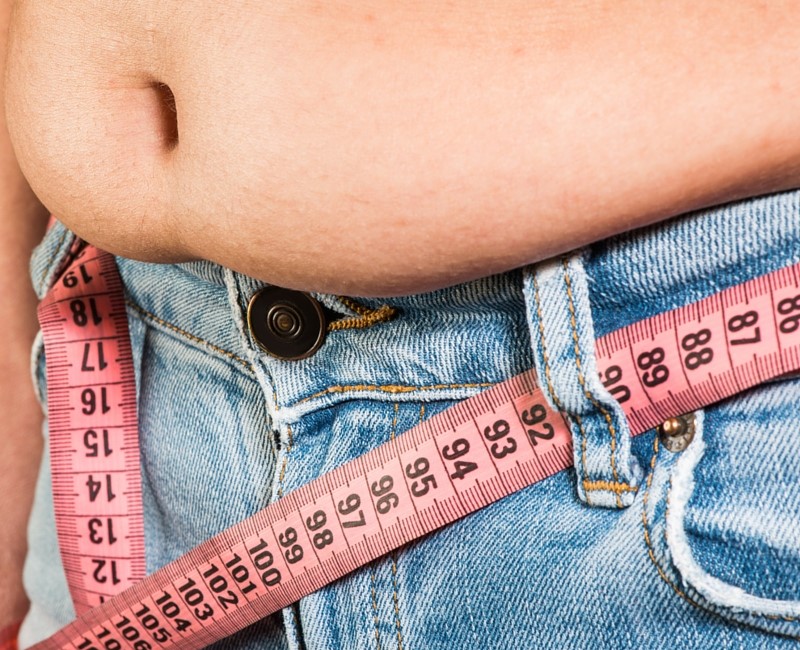 One of the best ways to know if you have this serious problem of insulin resistance is to have your doctor run a fasting insulin test. Unfortunately, these can be a bit pricey, so if that’s not an option then just look down and take a look at your belly size. If your currently obese and have increased belly fat like I did, then most likely you have a form of insulin resistance. Another more accurate way to see if you have insulin resistance is to check your ratio of Triglycerides to HDL cholesterol. You can do this by having your doctor run a standard lipid panel, then divide the number of triglycerides by the number of HDL-C and if the result is greater than 3.0 then you may have Insulin Resistance. There is also a link between skin tags as a possible sign of insulin resistance. So, if you have more than three skin tags that have recently shown up, then consider insulin resistance as a possible cause.
One of the best ways to know if you have this serious problem of insulin resistance is to have your doctor run a fasting insulin test. Unfortunately, these can be a bit pricey, so if that’s not an option then just look down and take a look at your belly size. If your currently obese and have increased belly fat like I did, then most likely you have a form of insulin resistance. Another more accurate way to see if you have insulin resistance is to check your ratio of Triglycerides to HDL cholesterol. You can do this by having your doctor run a standard lipid panel, then divide the number of triglycerides by the number of HDL-C and if the result is greater than 3.0 then you may have Insulin Resistance. There is also a link between skin tags as a possible sign of insulin resistance. So, if you have more than three skin tags that have recently shown up, then consider insulin resistance as a possible cause.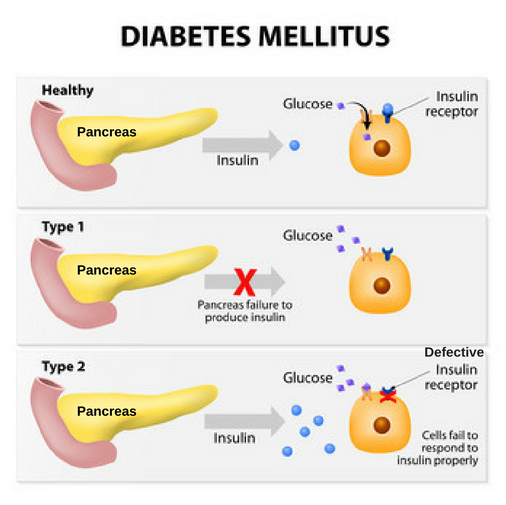 Just to give you an idea of why insulin is such a big factor for weight loss we can look at people with type 1 diabetes. These people are born with a pancreas that unfortunately can’t produce insulin. In some of them, a clue to their diagnosis was that they were thin, tired and had trouble putting on weight. An untreated Type 1 Diabetic can eat and eat but they don’t put on much weight. This is because they don’t have the ability to secrete the hormone insulin that is needed for the use and storage of energy. This is a big problem for Type 1’s because they don’t get the nutrients their cells need and so they have to inject themselves with insulin to be able to absorb the nourishment. The majority of us living in modern cultures have the opposite problem, we have too much insulin being secreted leading to issues with insulin cell receptors.
Just to give you an idea of why insulin is such a big factor for weight loss we can look at people with type 1 diabetes. These people are born with a pancreas that unfortunately can’t produce insulin. In some of them, a clue to their diagnosis was that they were thin, tired and had trouble putting on weight. An untreated Type 1 Diabetic can eat and eat but they don’t put on much weight. This is because they don’t have the ability to secrete the hormone insulin that is needed for the use and storage of energy. This is a big problem for Type 1’s because they don’t get the nutrients their cells need and so they have to inject themselves with insulin to be able to absorb the nourishment. The majority of us living in modern cultures have the opposite problem, we have too much insulin being secreted leading to issues with insulin cell receptors.
